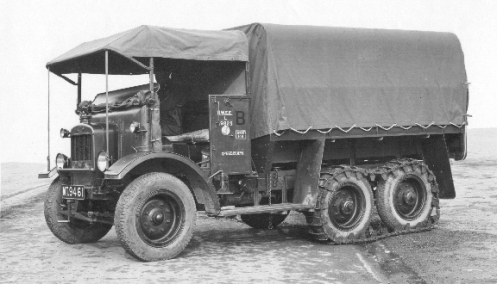Pre-war vehicle numbering of the Canadian Army
By Clive M. Law
The Canadian Army did not boast a large mechanised force in the years building up to the Second World War. They did, nonetheless, have a fleet of almost 200 vehicles, with most of these consisting of artillery tractors, 15 hundredweight (cwt) trucks and a medley of cars, motorcycles and other utility trucks.
The vehicle numbering system to this fleet varied considerably with the consistent element being the holding unit’s official abbreviation shown on the front door panel. This lack of consistency was addressed in a letter from Lt .P. Jolley to the head of the Directorate of Mechanization and Artillery Colonel N.O. Carr (often called No Carr by his detractors) in March 1937 after Jolley’s return from an Ordnance Course in England.

This 1919 Vulcan shows the markings applied to British Army vehicles. The photo is dated 1931. MilArt photo archives

A close-up of the Vulcan. The marking shows the truck belongs to the Mechanized Wheeled Experimental Establishment and was the 825th vehicle purchased in 1919. MilArt photo archives

Earlier markings for truck number 2 of B Battery, 2nd Regiment Royal Canadian Artillery. MilArt photo archives
In addition to his more complete report to Headquarters, Jolley drafted a memorandum on 25 November 1936, outlining British practice in vehicle marking. In his memo he writes;
The following notes on the subject of the marking of military vehicles, based on instructions received during the 10th Ordnance Mechanical Engineer’s Course, 1934-1935, are submitted for your information;
Classification of vehicles
“A” vehicles – All tracked and semi-tracked vehicles and armoured cars.
“B” vehicles – All load and passenger carrying vehicles (all vehicles on pneumatic tyres except armoured cars).
Letters and numbers –
L – Lorry
M – Motorcar
C – Motorcycle
D – Dragon
T – Tank or Tractor
H – Half-track
A – Ambulance
V – Van
X – Trailer
Since, and including, 1933 numbers of “B” vehicles have been arranged to indicate the dates of purchase of the vehicle. The system of numbering provides for 999 new vehicles per year, as the maximum[i]. The series for 1936 is, accordingly 36001 to 36999.
The numbering portion was to be applied in white paint while the “A” and “B” classifications were to be in red.
The memo then showed a drawing of a British Army marking currently in use.

Jolley’s drawing of a British marking for the 2nd Battalion, Royal Welsh Fusiliers. The “L” denotes Lorry and the number denotes that this is the 1st vehicle purchased in 1936. MilArt photo archives
Carr passed the memo up the chain and included a hand-written comment, saying “I think this method is worth adopting”. By 11 December, this system was recommended to the Deputy Minister of National Defence and was approved by him for use in the Canadian Army in a 22 Januray 1937 letter. At the same time, the Deputy Minister ordered that the RCAF also standardize the markings on their motor vehicles.

Proposed method of numbering RCAF vehicles. THere is little photographic evidence to show that this scheme was actually used. MilArt photo archives
To put the new scheme into effect Col Carr drafted a memo outlining the new system, stating;
The number to be allocated is now a Departmental matter. Hence it is recommended that numbers for all new vehicles be made to incorporate the year of purchase as a prefix, and that numbering be in accordance with the following series, year by year.
For Ordnance vehicles
1937 series – 37-1-1, 37-1-2, 37-1-3, etc.
1938 series – 38-1-1, 38-1-2, 38-1-3, etc.
For R.C.SA.S.C (Royal Canadian Army Service Corps) vehicles it is suggested that numbers might be as follows[ii]
1937 series – 37-1, 37-2, 37-3, etc.
1938 series – 38-1, 38-2, 38-3, etc.
Carr concluded his memo with the comment that “vehicles already numbered should retain their original identification.” Notwithstanding this, photographic evidence shows that earlier vehicles were re-numbered.

A 1935 Phaeton. Although this looks more suitable to its role as a roadster it was actually used as a field car. MilArt photo archives
This method of vehicle numbering remained in use through to 1942 for all Canadian Army vehicles in Canada. Vehicles used by the Canadian Army overseas adopted a new numbering scheme which will be addressed in another MilArt article.

This 1940-plated vehicle belongs to “A” Squadron, Royal Canadian Dragoons and is marked as “M” for motorcar and 36-1-99 denoting the 99th vehicle purchased in 1936. MilArt photo archives
_______________________________________________________
[i] Although no one in the Canadian Army could have conceived purchasing more than 999 new vehicles in a single year, an unsigned minute, located at the foot of the memo, suggests that “the yearly serial number can be extended to any required extent.”
[ii] RCASC vehicles were those that were not operated uniquely by a unit as part of that unit’s establishment. These vehicles included buses, Stores lorries, staff cars and vehicles used in support of Base maintenance.
You can rate this article by clicking on the stars below.





